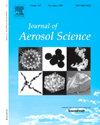选择电子尼古丁传递系统(ENDS)成分在青少年和年轻人中的命运
IF 3.9
3区 环境科学与生态学
Q2 ENGINEERING, CHEMICAL
引用次数: 0
摘要
电子尼古丁传递系统(ENDS)的使用在青少年和年轻人中很普遍。虽然已经有几项努力来估计成年人对ENDS烟雾成分的暴露和剂量,但迄今为止还没有针对年轻ENDS使用者的研究。鉴于肺的生长随年龄的增长而不均匀,年轻人的肺不能被认为是成年人肺的缩小版;此外,呼吸轮廓和流速可能随着年龄的增长而显著不同。因此,为成人开发的吸入剂量学模型如果没有适当的修改,不能直接应用于青少年。我们将先前开发的成人气溶胶沉积模型扩展到更年轻的年龄层(10-21岁),方法是基于肺形态测量学的现有数据,开发针对年龄层的肺几何形状,并使用诸如基于相关气管尺寸的成人口腔体积等关系,使用不同年龄层吸入烟雾量的口腔体积和功能剩余容量(FRC)的关系。然后,我们使用年龄特异性沉积模型来预测含有选定成分(尼古丁、丙二醇、植物甘油、苯甲醛和香兰素)的ENDS喷雾剂的命运。在液滴沉积与蒸汽吸收方面,模型预测显示了与成人相似的沉积模式。肺中各成分的总沉积量和每表面积沉积量随年龄的增长而减少。年龄特异性沉积模型是预测ENDS气溶胶成分肺沉积和比较不同年龄组结果的有用工具。本文章由计算机程序翻译,如有差异,请以英文原文为准。
The fate of selected electronic nicotine delivery systems (ENDS) constituents in adolescents and young adults
Electronic nicotine delivery systems (ENDS) use is prevalent among adolescents and young adults. While there have been several efforts to estimate the exposure and dose of ENDS puff constituents in adults, no study to date has focused on younger ENDS users. Given the non-uniformity of lung growth with age, the lungs of young people cannot be considered miniature versions of those of adults; in addition, breathing profiles and flow rates may substantially differ with age. Thus, inhalation dosimetry models developed for adults cannot be directly applied to youth without proper modifications. We extended a previously developed ENDS aerosol deposition model for adults to younger ages (10–21 years) by developing age-specific lung geometries based on available data on lung morphometry and using relationships such as the volume of the oral cavity of adults based on the relevant trachea dimensions, using relationships for volume of the oral cavity for inhaled puff volume, and functional residual capacity (FRC) at different ages. We then used the age-specific deposition model to predict the fate of an ENDS puff with selected constituents (nicotine, propylene glycol, vegetable glycerin, benzaldehyde, and vanillin). Model predictions showed similar patterns of deposition to those of adults in terms of droplet deposition versus vapor uptake. Total deposition and deposition per surface area of individual constituents in the lung decreased with age. The age-specific deposition model is a useful tool to predict lung deposition of ENDS aerosol constituents and compare results across different age groups.
求助全文
通过发布文献求助,成功后即可免费获取论文全文。
去求助
来源期刊

Journal of Aerosol Science
环境科学-工程:化工
CiteScore
8.80
自引率
8.90%
发文量
127
审稿时长
35 days
期刊介绍:
Founded in 1970, the Journal of Aerosol Science considers itself the prime vehicle for the publication of original work as well as reviews related to fundamental and applied aerosol research, as well as aerosol instrumentation. Its content is directed at scientists working in engineering disciplines, as well as physics, chemistry, and environmental sciences.
The editors welcome submissions of papers describing recent experimental, numerical, and theoretical research related to the following topics:
1. Fundamental Aerosol Science.
2. Applied Aerosol Science.
3. Instrumentation & Measurement Methods.
 求助内容:
求助内容: 应助结果提醒方式:
应助结果提醒方式:


